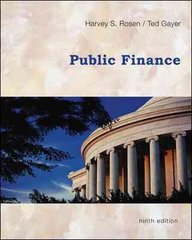Question
1. Which of the following is TRUE about the mean-variance criterion? Select one: a. When the degree of risk aversion A > 0, the investor
1. Which of the following is TRUE about the mean-variance criterion?
Select one:
a. When the degree of risk aversion A > 0, the investor is risk loving.
b. When the degree of risk aversion A = 0, the investor does not care about the expected return of an investment.
c. When the degree of risk aversion A < 0, the investor is risk averse.
d. The certainty equivalent is the utility score of an indifference curve.
e. The indifference curves of a particular mean-variance investor intersect one another at different levels of utility.
.
.
.
2. In a hypothetical financial market, there are two stocks and a risk-free asset. If mean-variance investors (with risk aversions A > 0) are ONLY allowed to own one stock together with the risk-free asset, which of the following statement is TRUE?
Select one:
a. An investor with a higher A, compared to another investor with a lower A, will choose the stock with higher expected return.
b. An investor with a higher A, compared to another investor with a lower A, will choose the stock with lower standard deviation.
c. An investor with a higher A, compared to another investor with a lower A, will choose the stock with higher Sharpe ratio.
d. An investor with a higher A, compared to another investor with a lower A, will choose the stock with lower Sharpe ratio.
e. I cannot find a correct statement.
Step by Step Solution
There are 3 Steps involved in it
Step: 1

Get Instant Access to Expert-Tailored Solutions
See step-by-step solutions with expert insights and AI powered tools for academic success
Step: 2

Step: 3

Ace Your Homework with AI
Get the answers you need in no time with our AI-driven, step-by-step assistance
Get Started


